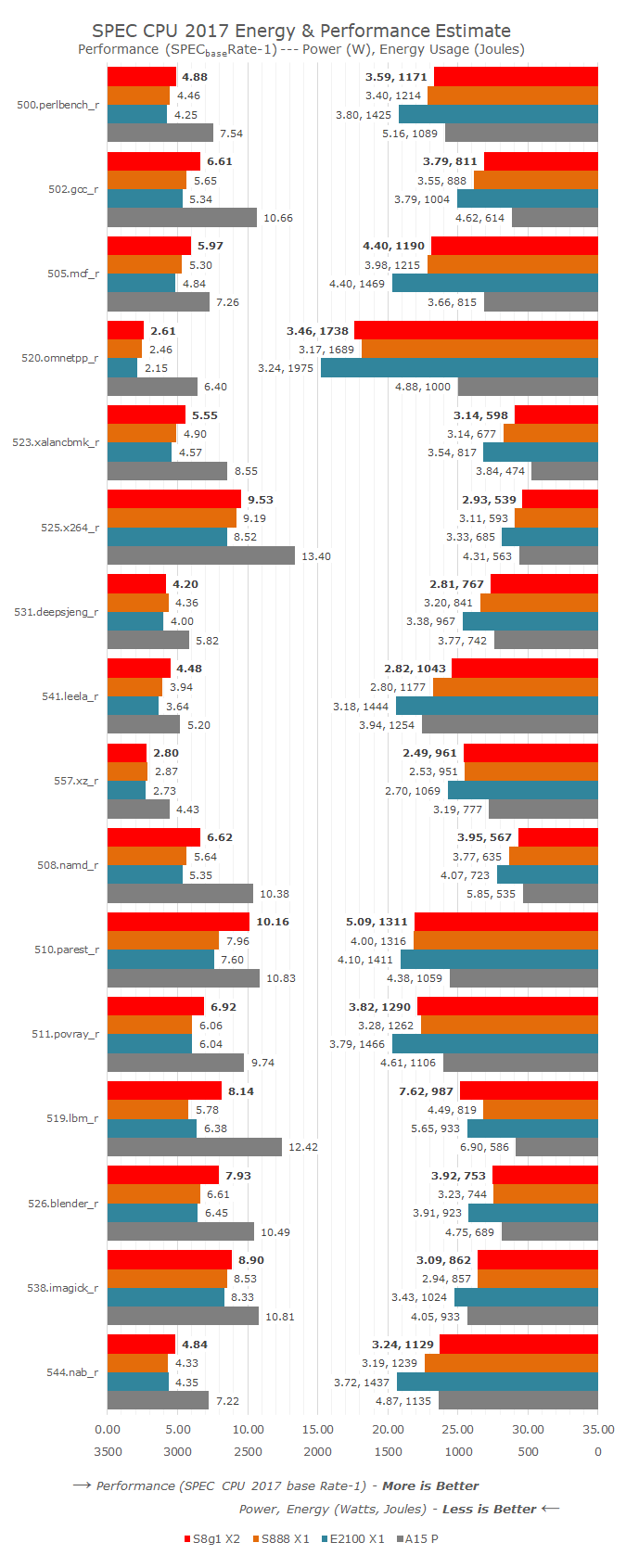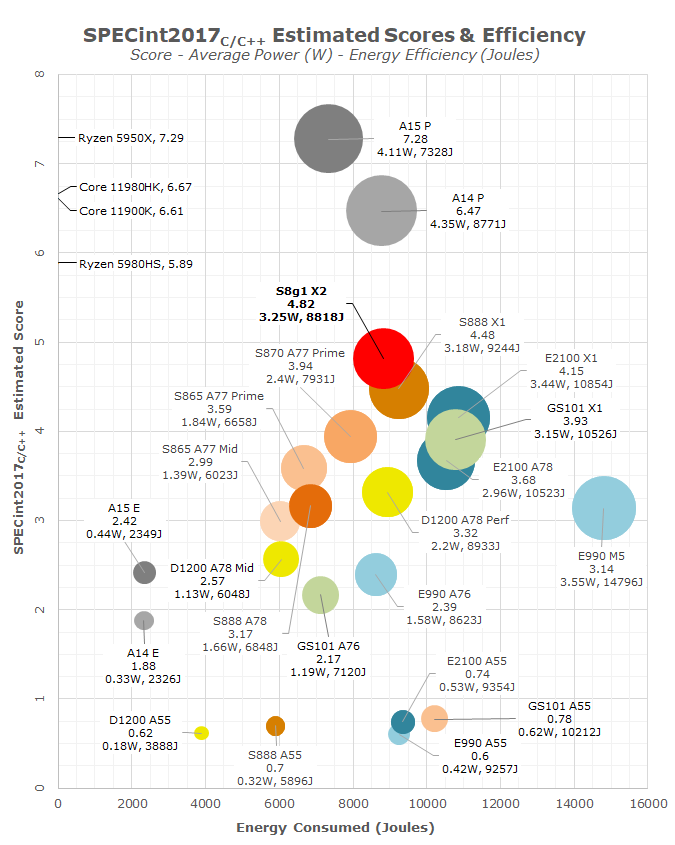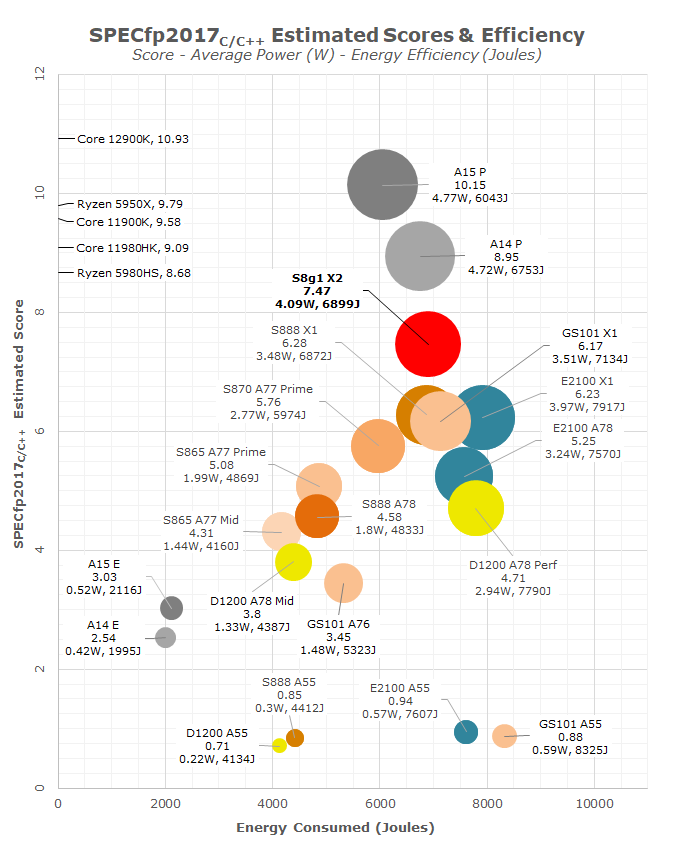The Snapdragon 8 Gen 1 Performance Preview: Sizing Up Cortex-X2
by Dr. Ian Cutress on December 14, 2021 8:00 AM ESTTesting the Cortex-X2: A New Android Flagship Core
Improving on the Cortex-X1 by switching to the Arm v9 architecture and increasing the core resources, both Arm and Qualcomm are keen to promote that the Cortex-X2 offers better performance and responsiveness than previous CPU cores. The small frequency bump from 2.85 GHz to 3.00 GHz will add some of that performance, however the question is always if the new manufacturing process coupled with the frequency increase allows for better power efficiency when running these workloads. Our standard analysis tool here is SPEC2017.
Running through some of these numbers, there are healthy gains to the core, and almost everything has a performance lift.
On the integer side (from 500.perlbench to 557.xr), there are good gains for gcc (+17%), mcf (+13%), xalancbmk (+13%), and leela (+14%), leading to an overall +8% improvement. Most of these integer tests involve cache movement and throughput, and usually gains in sub-tests like gcc can help a wide range of regular user workloads.
Looking at power and energy for the integer benchmarks, we’re seeing the X2 consume more instantaneous power on almost all the tests, but the efficiency is kicking in. That overall 8% performance gain is taking 5% less total energy, but on average requires 2% more peak power.
If we put this core up against all the other performance cores we test, we see that 8% jump in performance for 5% less energy used, and the X2 stands well above the X1 cores of the previous generation, especially those in non-Snapdragon processors. There is still a fundamental step needed to reach the Apple cores, even the previous-generation A14 performance core, which scores 34% higher for the same energy consumed (albeit on average another 34% peak power).
Just on these numbers, Qualcomm’s +20% performance or +30% efficiency doesn’t bare fruit, but the floating point numbers are significantly different.
Several benchmarks in 2017fp are substantially higher on the X2 this generation. +17% on namd for example would point to execution performance increases, but +28% in parest, +41% in lbm and +20% in blender showcases a mix of execution performance and memory performance. Overall we’re seeing +19% performance, which is nearer Qualcomm’s 20% mark. Note that this comes with an almost identical amount of energy consumed relative to the X1 core in the S888, with a difference of just 0.2%.
The major difference however is the average power consumed. For example, our biggest single test gain in 519.lbm is +41%, but where the S888 averages 4.49 watts, the new X2 core averages 7.62 watts. That’s a 70% increase in instantaneous power consumer, and realistically no single core in a modern smartphone should draw that much power. The reason why the power goes this high is because lbm leverages the memory subsystem, especially that 6 MiB L3 cache and relies on the 4 MiB system level cache, all of which consumes power. Overall in the lbm test, the +41% performance costs +20% energy, so efficiency is still +16% in this test. Some of the other tests, such as parest and blender, also follow this pattern.
Comparing against the competition, the X2 core does make a better generation jump when it comes to floating point performance. It will be interesting to see how other processors enable the X2 core, especially MTK’s flagship at slightly higher frequency, on TSMC N4, but also if it has access to a full 14 MiB combination of caches as we suspect, that could bring the power draw during single core use a lot higher. It will be difficult to tease out exactly who wins what where based on implementation vs. process node, but it will be a fun comparison to make when we look purely at the X2 vs. X2 cores.
Unfortunately due to how long SPEC takes to run (1h30 on the X2), we were unable to test on the A710/A510. We’ll have to wait to see when we get a retail unit.













169 Comments
View All Comments
TheinsanegamerN - Friday, December 17, 2021 - link
The android world doesnt need 6-10 years of support to still download and play the latest games, unlike iphones. Android 6 can play anything android 12 can.Now try that with iOS 9.
Sergio Luiz - Saturday, June 25, 2022 - link
The problem here is that the IPhone 6s not only has the latest version of ios but all the compilers updated to run current games, see that the A9 runs the immortal Diablo in its Medias settings at 30fps, the updates survive longer for the devices, already that in each version of Apple makes improvements in the APIs of the devices, 6s will only not be compatible with ios 16 because of Metal 3 that will only be available on the A11 Bionic, but see that the 6s has not died yet because most Apps need ios 11 to run.Nicon0s - Saturday, December 18, 2021 - link
"The 6-10 years of support for iPhones more than mitigates what is at this point a very minor price difference outside of the very low end."LoL, 10 years of support? These same excuses are really funny.
Phones hardly even last for 10 years, in general and after 2 years you need to change the battery especially with iphones so 5 years is the longest people keep their phones in general. And these are generally people that don't care about software updates, they don't even know what software version their phones has, they don't care what hardware their phones has and so on. The idea is that Android phones can be used for 5 years or more no problem. My A52s will get 4 years of updates but project Mainline will make it so the phone will continue to get updates well past that threshold, so I could probably keep it for as long it would last hardware wise.
"iPhone SE is only $400 after all."
The SE is a terrible phone in 2 very important areas: BATTERY and SCREEN.
It's OK for phone calls and basic stuff that doesn't stress the batter but in such cases even a low end Android phone is just as good.
"Android phones in that price range are not great performers and have at best 2 years of support typically."
Well I payed 350 Euros, VAT included for my A52s 5G also with a free pair of Galaxy Buds2. An SE would cost me 500 Euros with VAT and I struggle to think about anything that would make it better as a phone. Other that a nicer built quality(which is irrelevant as I always uses cases with my phones) there isn't really anything relevant. Oh and the A52s has official software support for 4 years.
"Even a used iPhone will typically have years more support than a comparably cheap new Android device, and for a non-power user that's great."
For a non-power user that's actually irrelevant.
Reflex - Monday, December 20, 2021 - link
This is silly, I mean, iPhone batteries are as good or better than their Android counterpoints in similar price ranges. And no, the SE is not a terrible phone, it's just not a power users' phone. Nothing wrong with mid-range products, and they exist in the Android ecosystem as well.The issue with using Android past it's support lifecycle is that it is easily compromised, I've delt with dozens of people, most often seniors, with tons of spyware on their phones due to one click sms malware or following the wrong email link. It's important to have ongoing security updates to any computing device in active use as users simplly are not a reliable source of security.
Nicon0s - Saturday, December 25, 2021 - link
"This is silly, I mean, iPhone batteries are as good or better than their Android counterpoints in similar price ranges."SE's battery is way worse in comparison to any Android phone in it's price range. So your claim is the silly one sir.
"And no, the SE is not a terrible phone, it's just not a power users' phone."
I guess if you expect to be able to use your phone throughout the entire day you are a "power user".
"Nothing wrong with mid-range products, and they exist in the Android ecosystem as well."
It's funny how you try to defend it. I didn't say there's any problem with mid-range phones, I only said the SE is bad in 2 very important areas, which obviously you can't deny.
"The issue with using Android past it's support lifecycle is that it is easily compromised"
No it's not.
"I've delt with dozens of people, most often seniors, with tons of spyware on their phones due to one click sms malware or following the wrong email link."
Yeah, I'm sure you didn't. Realistically if you click or tap on anything every time, you can get compromised on any phone no matter the OS version. iOS for example is full of 0 day vulnerabilities, way more than Android.
"It's important to have ongoing security updates to any computing device in active use as users simplly are not a reliable source of security"
It is important but not life dependent, or better it doesn't make a phone unusable, useless device that will surely be compromised. I have lots of phones, some of them on older Android versions and I've never encountered a "malware" in the last 10 years. Maybe I'm doing something wrong, I should start tapping of suspicious links from unknown senders.
lemurbutton - Tuesday, December 14, 2021 - link
Android phones will never have better value than iPhones unless you go into the sub $200 range. iPhones have much higher resale value. Android phone values tank fast.TheinsanegamerN - Tuesday, December 14, 2021 - link
Android users dont have to have the new shiney every year, unlike iphone users, so who cares?Wrs - Tuesday, December 14, 2021 - link
For there to be a resale value there must be demand for the secondhand device or its parts. Clearly there’s huge relative demand for secondhand iPhones as compared to most Androids. Why?michael2k - Tuesday, December 14, 2021 - link
Because Apple provides updates for 6 years. Meaning a 3 year old iPhone will receive as many OS updates as a brand new 2021 Android phone.And from the charts, a 3 year old iPhone will perform as well as a brand new 2021 Android phone.
Reflex - Wednesday, December 15, 2021 - link
It's actually closer to ten years. Apple provides six years of major OS updates, however each major OS version gets four years of security updates which is why the iPhone 6S, which is six years old but just got iOS 15, still has four more years of support left.Huge selling point for the people I support given their lack of interest in the latest and greatest.